
How to shop at Borough Market in the summer
Food markets fizz with a very particular kind of energy in the summer months. That’s as true anywhere as at Borough Market where the energy somehow hits me as I’m still walking the stairs up from London Bridge tube, way before I even see the market gates. It’s not just the sun’s moodlift that makes things palpably different in the summer than at any other time of year – it’s the distinctive culmination of the summer vibes that marketgoers bring. Whether seasonal cooks there to stock up on longed-for summer produce; friends on a wander for a day out; or food lovers after a few deliciously easy wins to enjoy on a rug somewhere. Any kind of picnic (garden/beach/park/lounge) can be so easily catered for at a food market. In one swoop you can pick up chilled bottles of interesting wines, beers and softs; breads for ripping into; butter and seasonal young cheeses; charcuterie; salty black olives, and all kinds of fabulous fruits. Tins of preserved fish make for interesting rug-chat over the beautiful boxes. At Borough there’s no shortage of choice of those at The Tinned Fish Market stall. Sometimes there I’ll go for the Cântara small squid stuffed with onion, rice and tomatoes; other times the Pepus mussels in escabeche. Or else it’s the never-fail Ortiz tuna at Brindisa, home to so many foods that are a picnic-maker’s dream. (Fino sherry, truffle crisps, jamon, salted almonds… do I need to go on?) That ease the food markets gift to feeding a gathering translates seamlessly to the ease they offer summer’s everyday cooking and eating. The stalls (almost) struggling to fit in all the magnificent seasonal produce that is so often best enjoyed when hardly anything is being done to it. Courgettes, peppers and aubergines gleam with proud beauty among the glory of all the other summer vegetables and fruits. Pods of garden peas and broad or borlotti beans beg to be bought by the bagful. All of them are a joy to mindlessly and mindfully pop out of the shells when you get home, but the borlottis perhaps most of all as that’s the only way to really be able to admire the purple mottles of the bean before it disappears upon cooking. The best seasonal tomatoes need little more than olive oil and salt to bring out their supreme flavour. Salad options are inexhaustible – go for big sharing bowls of a fattoush or panzanella; or the neat Nicoise bundles featured in Borough Market: The Knowledge. There the classic Nicoise elements of anchovy, mayonnaise, capers and egg are piled aboard little gem boats for ease of eating. Another of my all-time favourite summer salads is in that book too: oregano-poached peaches, halloumi and hazelnuts. Its mix of sweetly salty flavours manages to be simultaneously refreshing and completely beautiful on the plate. The peaches in it becoming the very best version of themselves by being poached with dried oregano and honey. The choice of honey is no accident. In the summer I always make sure to stock up at the market on blossom honeys that will delicately yet effectively infuse so many foods – and drinks – with a floral undernote. Perhaps the lavender honey at From Field and Flower, or the wild thyme at Oliveology. That’s the one I use in the dressing for making The Knowledge’s labneh with watermelon, honey and mint. It’s a recipe that straddles the boundary of sweet and savoury, with watermelon griddled in olive oil, orange and sumac for peak refreshment. My top tip in making this is to always do more labneh than needed in the recipe because it is such a useful thing to be able to reach for in the fridge. All it takes is 900g of really good, thick Greek yoghurt mixed with 1 teaspoon of salt and spooned into a muslin-lined sieve. Let that drain for 6-12 hours (depending how thick you want it – longer equals thicker) and the result is approximately 500g of labneh. Use it for salads, or to spread on toast with perhaps just a few sliced apricots. Summer is mackerel season at the market. A fish that is packed with flavour and goodness, and also incredibly easy to cook. Griddle it, bake it, fry it, or over-fire it. And then, when any kind of cooking seems impossible in the heat, even sit it in vinegar for a while and let its acidity do the “cooking” for you. Try the same thing with the small fresh anchovies that the fishmongers also have in now. They absolutely don’t need to be gutted, but the skilled fishmonger will happily do it for you (and at the same time showcase exceptional filleting knife skills). Whenever I head to the market on a produce-shopping mission it tends to be just that – a mission. I do try to make sure to spend time checking out what is what because the very nature of market shopping is that it is never the same. What the stalls offer week on week is at the mercy of not just the season but whatever choices traders have been made on what to stock that week, that day. Yet, as I beetle around, I am always a bit envious of the market wanderers. It’s a feeling that grows even stronger in the summer when these marketgoers without any agenda of shopping lists to mark off, or a fridge to fill, are enjoying being among all the glorious foods on the day out with friends and family. With nothing to do except admiringly soak it all up while stopping off for the occasional energy-boost by way of an ice-cream or a glass of something coolly bolstering. What a great way to spend a day. The cooks, the picnic-ers, the wanderers. Each as welcome and as catered for in a summertime market. All playing a key role in building the atmosphere that makes these months there so deliciously special. For more information on what you can find at Borough Market, visit: boroughmarket.org.uk Read More Three quick and easy vegan fakeaway recipes The only three recipes you need to seize the summer Budget Bites: Three light recipes that sing of summer What the hell is Scandinavian food? Lighter fish pie: Comfort food you won’t feel guilty for eating How to make Norwegian potato pancakes
2023-07-03 14:18
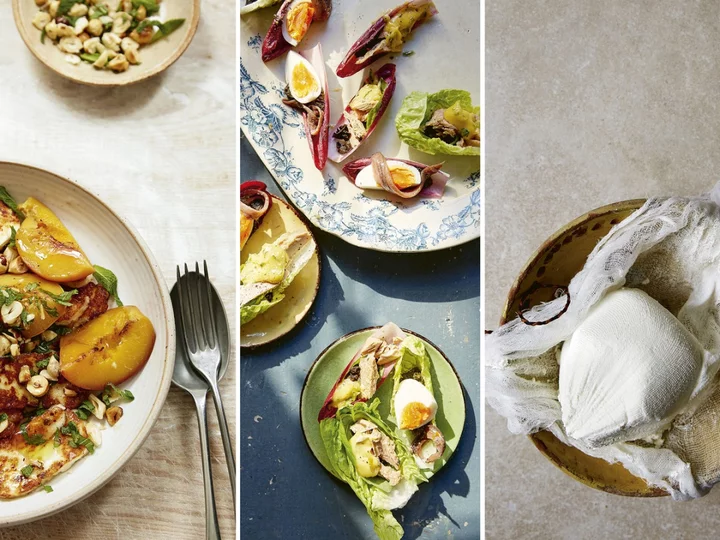
The only three recipes you need to seize the summer
As the weather warms up and the nights get longer, there’s nothing better than a light and colourful summery feast in the garden, balcony, doorstep or basically any perch in the sun you can find. And there’s few who do it quite as well as Angela Clutton, author of Borough Market: The Knowledge. In her summer column for The Independent, she shares one of her all-time favourite salads: oregano-poached peaches, halloumi and hazelnuts. A mix of sweet and salty flavours, it’s simultaneously refreshing and completely beautiful on the plate. What’s summer without tomatoes? Terrible, that’s what. Clutton says the best seasonal toms need little more than olive oil and salt to bring out their supreme flavour and the salad options are inexhaustible. But one not to be missed is her Nicoise “bundles”. The classic Nicoise elements of anchovy, mayonnaise, capers and egg are piled abord little gem boats for ease of eating. Lastly, her labneh with watermelon, honey and mint is a recipe that straddles the boundary of sweet and savoury, perfect for those for whom dessert is not a priority. Her top tip is to always do more labneh than needed, as it’s such a useful thing to be able to reach for in the fridge. Equipped with these recipes, you’ll be dining al fresco – or faking it indoors if it, ahem, rains – all summer long. Oregano-poached peaches, halloumi and hazelnuts There are fresh herbs, there are dried herbs, and then there are frankly incredible dried herbs. Into that last camp fall dried herbs that are produced to exceptionally high standards and don’t just harness the flavour of the starting point, but elevate it. Those are the only dried herbs really worth having in your store cupboard. This recipe goes for poaching fresh peaches with dried oregano, which brings even more depth of flavour than fresh oregano would. Given the choice, I use one of the beautiful dried sprigs at Oliveology, but their ground oregano is lovely too. The poaching liquor is then reduced to a fragrantly sweet syrup for pouring over tender peach slices and fried halloumi, and finished with seasoned toasted nuts and mint. Perfect for a hot day. Serves: 2 as a main, 4 as a side or small plate Ingredients: 2 tsp dried oregano (or an Oliveology dried sprig) 1 tbsp honey 1 orange 2 peaches 40g skinned whole hazelnuts 1 tbsp fruity olive oil 6 sprigs of mint 225g halloumi Method: Pour 500ml water into a medium saucepan. Add the dried oregano (or oregano dried sprig), the honey and two broad strips of zest from the orange. Bring to the boil and, meanwhile, quarter and stone the peaches. Put them into the water, lower the heat to a simmer and sit a piece of baking paper on top. Simmer for 7-10 minutes until the peaches are fully tender. Use a slotted spoon to lift the peaches out and set aside. If their skins start to flake away as they cool, just peel them off. Strain the poaching liquor, discard the oregano and orange peel, then pour the poaching liquor back into the saucepan. Don’t worry if a few pieces of oregano are left in the liquid. Boil over a high heat for 10-15 minutes to reduce to a syrup – you are aiming for about 75ml syrup. While the poaching liquor reduces, toss the hazelnuts in the olive oil along with some salt flakes and freshly ground black pepper. Set a small dry frying pan over a low heat, then add the seasoned nuts and stir for 3 minutes or until they are just getting nicely toasted. Transfer to a bowl. Once they have cooled, roughly chop with the leaves from the mint sprigs. Cut the poached peach quarters into slices about 1cm thick. Once the syrup is almost sufficiently reduced, cut the halloumi into 1cm-thick slices. Set the same frying pan the nuts cooked in back onto the heat, then add the halloumi pieces turning each over after 2 minutes or so once they are browned. You might need to do this in two batches. Serve either on individual plates or on a large platter. Sit the halloumi on first, then arrange the peach slices prettily on top, scatter over the seasoned nut and mint mixture, and finish by spooning over your oregano-infused peach syrup. Niçoise bundles The classic niçoise salad is served here as individual bundles that are perfect for a summer lunch or starter. I’m giving you two versions: one layers up blitzed olives and capers with egg and an anchovy; for the other, flaked tuna sits on an olive bed with tarragon mayo. Their simplicity makes it important that each ingredient is chosen for maximum flavour. Perhaps especially the fish. I make these with (my favourite) Brindisa Ortiz anchovies and the same maker’s yellowfin tuna belly ‘ventresca, which in one bite of its long, tenderly rich hakes took me from thinking I didn’t really like tinned tuna to stockpiling it. Serves: 4 as a main or 8 as a small plate or starter Ingredients: 16 leaves of little gem lettuce and/or red chicory For the tarragon mayonnaise: 1 egg yolk, at room temperature 1½ tsp moscatel wine vinegar ¼ tsp English mustard powder 100ml sunflower oil 50ml mild olive oil 1 sprig of tarragon For the olive and tuna mix: ½ tsp raspberry vinegar 8 basil leaves 100g pitted black olives, drained weight 110g tinned yellowfin tuna For the egg, olive and anchovy mix: 2 hen’s eggs or 4 quail’s eggs 150g pitted black olives 2 tsp capers 1 garlic clove 7ml peppery olive oil, plus 1 tbsp for drizzling ½ lemon 8 anchovy fillets Method: Wash and dry the lettuce or red chicory leaves. For half of the little gem/chicory leaves: Make the mayonnaise by gently hand-whisking the egg yolk with a pinch each of salt and ground pepper. Stir in the vinegar and the mustard powder, then hand-whisk in both the oils — drop by drop to start with, then in a steady, thin stream — until you have a lovely thick, shiny mayonnaise. Check the seasoning, chop the tarragon leaves and stir through. Sprinkle a little raspberry vinegar, salt and pepper inside eight of the little gem / chicory leaves and line with a basil leaf. Chop the olives and sit them inside. Top with flaked tuna. Serve with the tarragon mayonnaise on top, or alongside to be spooned over. For the other half of the leaves: Hard-boil the 2 hen’s eggs (or 4 quail’s eggs) and set aside to cool. Put the olives, drained capers, peeled garlic, 75ml of olive oil and a good squeeze of lemon juice in a blender and blitz to a paste. Peel the hard-boiled eggs. Quarter them if hen’s, halve if quail’s. Spoon the oli relish inside the lettuce / chicory leaves, sit a piece of egg inside too and then over the top the whole anchovy fillet. Drizzle with the remaining olive oil. Serve the bundles on platters for people to help themselves, or portion up two of each type per person. Labneh with watermelon, honey and mint I like to serve this as part of a medley of salads on a hot day. Or – noting that it is really on the cusp of savoury or sweet – lean into the sweetness and hold back a little on the salt: as a dessert it is especially appreciated by anyone without a super-sweet tooth. Making your labneh is simplicity itself – it is, after all, just strained yoghurt – and a lovely thing to do, so long as you start at least six hours before wanting to eat it. Actually, every part of this recipe can be made ahead of time, chilled, then quickly assembled for serving at room temperature. Serves: 6 as part of a sharing feast Ingredients: 500g labneh made from 900g thick Greek yoghurt (see box) About 800g watermelon 2 tbsp olive oil ½ orange 1 tsp wild sumac 2 tbsp wild thyme honey Handful of mint Method: Spoon the labneh into a large serving bowl. Trim the ends of the watermelon and cut the fruit into triangles about 1cm thick. Mix the olive oil with the juice from the orange, half the sumac and a good pinch of salt. Get a griddle pan (or barbecue) good and hot, brush the watermelon pieces with the dressing and sit the pieces in a single layer in the pan (or on the grill). If using a griddle pan you will probably need to do this in two batches. Turn them over after a couple of minutes, when nicely charred underneath. Let the other side char, then lift the slices out to cool. Add any juices from the pan to your leftover oil, orange and sumac dressing. Whisk in the honey and the rest of the sumac. Add more salt. Sit the watermelon pieces on the labneh and pour over the dressing. Chop the mint and scatter over, then finish with a grinding of black pepper. You can visit Borough Market at 8 Southwark Street, London, SE1 1TL (020 7407 1002) or find more recipes online at boroughmarket.org.uk/recipes. Read More Three quick and easy vegan fakeaway recipes Budget Bites: Three light recipes that sing of summer What the hell is Scandinavian food? Lighter fish pie: Comfort food you won’t feel guilty for eating How to make Norwegian potato pancakes Rhubarb sticky buns for an idyllic Scandinavian afternoon tea
2023-07-03 13:52

Nutritionist explains how women can eat to help balance hormones
Some healthy eating principles apply to just about everyone – drinking enough water and consuming plenty of fresh fruit and veg, for example. But when it comes to hormones, a lot of diet advice neglects to mention the vast difference between women’s and men’s health. “Women are very under-represented in research, mainly because we have a menstrual cycle,” says functional nutritionist and author Pauline Cox. “My passion and mission is to empower women with the information and knowledge that can radically change their immediate health and their long-term health.” Cox, 43, who started her career as a physiotherapist before becoming a nutritionist, now mainly works with groups of women online and has just released her second book, Hungry Woman: Eating for Good Health, Happiness and Hormones. “I felt there was a lot of information that could be shared with women to help them understand their hormones, and understand that we don’t have to get frustrated with ourselves and fight our female physiology.” At the heart of the issue is the balance (or lack thereof) between oestrogen and progesterone levels. “When our progesterone levels are low, our oestrogen can become dominant, and that’s when we start to see things like PMS, heavy periods, painful periods, flooding at the beginning of our periods,” says Cox, who lives in Somerset. “A lot o women accept that as part of their monthly cycle, but when we bring our progesterone levels back up, it helps to balance the effect of oestrogen.” Here, she explains five ways women can tailor their diets to keep their hormones in check… 1. Look after your liver “Oestrogen is a driving-growth hormone,” Cox explains, using the analogy of grass growing on a lawn to explain how the two hormones interact. “Progesterone is like the lawnmower. It comes along and it keeps the grass in check. When we lose progesterone, oestrogen gets out of control.” That’s why it’s important that our bodies are able to clear oestrogen efficiently through the liver, gut and bowels. “How much oestrogen we clear can be influenced by what we eat and how we live,” says Cox. “There’s a lot of cruciferous in the book – cauliflower, broccoli, these are really great vegetables to support liver detoxification.” 2. Add fermented foods To deliver beneficial bacteria to your gut, try including fermented foods like pickled vegetables, kefir, kombucha or natural yoghurt as part of your daily diet. “Our gut diversity declines as we age and microbiome diversity has been linked with longevity and good health,” says Cox, who suggests just a tablespoon of sauerkraut a day can make a difference. “These are easy wins…to maximise our longevity and optimise our gut-brain axis, which is incredibly important.” 3. Avoid ultra-processed foods There’s been a lot of talk recently about how detrimental ultra-processed foods are, and that includes the effect on hormone levels. “When we’re eating high sugar, processed foods, our inflammatory levels go up and our cortisol level goes up, which robs us of progesterone,” Cox says. Plus, filling up with these empty calories – as delicious as they often are – means we have less room for nutritious foods. “They can often be devoid of nutrients, so you’re not getting the nutrients you need for building hormones and supporting hormonal health like magnesium, zinc, B vitamins, and omega three fatty acids.” 4. Create an eating window It’s not just what you eat, it’s when. Cox recommends having an ‘eating window’ during the day that ends around 6pm, so that there’s a gap of a few hours before you go to bed. “When your blood sugars go up at night, your kidneys have to kick in to try and remove this excess blood sugar, which then means you’re up in the night urinating,” she says. “A lot of women associate this with drinking a lot before bed, but actually eating late at night can also be for that reason.” Choosing meals that are nutritious and satisfying is the next step. “Within that window, start becoming a bit more conscious of your carbs and upping your protein,” she continues. “So you’re feeling full, your body’s getting all the amino acids it needs, and you’re maybe not having so much of the grab-and-go food like the sandwiches, the pasta, the crisps.” 5. Monitor your magnesium “Most women are sub-clinically deficient in magnesium,” Cox explains, which can cause insomnia, and the risk increases with age. “As we get to about the age of 40, we absorb less magnesium than we would have in our 20s.” Diet also plays a role: “If we have high blood sugars and levels of inflammation when we’re stressed, we lose magnesium.” She recommends taking a magnesium glycinate or bisglycinate supplement before bed to increase your chance of getting a good night’s sleep. “The glycine part of that helps to reduce your core body temperature, which is what the body wants when it’s going to bed,” she says. “That compound also helps get you into what’s called REM sleep, which is the sleep where you’re consolidating memories and learning.” Hungry Woman by Pauline Cox is published by Ebury Press, priced £27. Photography by Luke Albert. Available Now. Read More From hairdressers to aloe vera: What will Diet Coke join as a ‘possible cancer risk’ Charity boss speaks out over ‘traumatic’ encounter with royal aide Ukraine war’s heaviest fight rages in east - follow live
2023-06-30 22:53

Pepsi Unveils Pepsi-Flavored Ketchup for the Fourth of July
Could the best ketchup contain cola? Pepsi is putting that question to the test.
2023-06-30 05:17
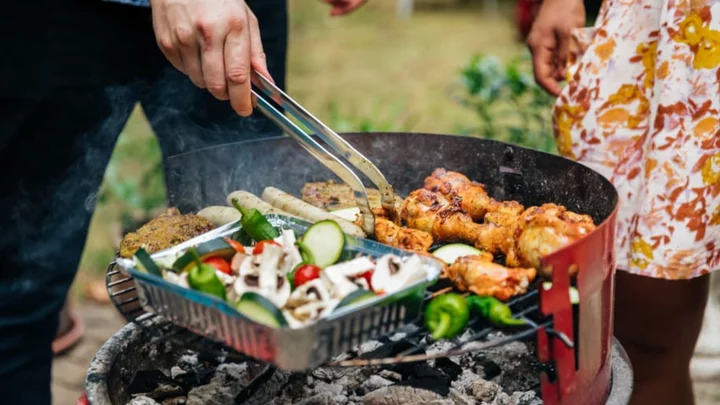
7 Tips for Better Barbecue, According to a BBQ Master
We asked Myron Mixon—a.k.a. the winningest man in barbeque—for some tips to help you nail it this barbecue season.
2023-06-30 02:58

Italy may have dodged a 'pasta strike' but food inflation is still high. Here's why
Italians were supposed to be on a "pasta strike" this week but it was called off after prices for the national staple started to fall. Zoom out, though, and global food prices are still far higher than a year ago, despite precipitous drops in the cost of key raw materials.
2023-06-29 22:49
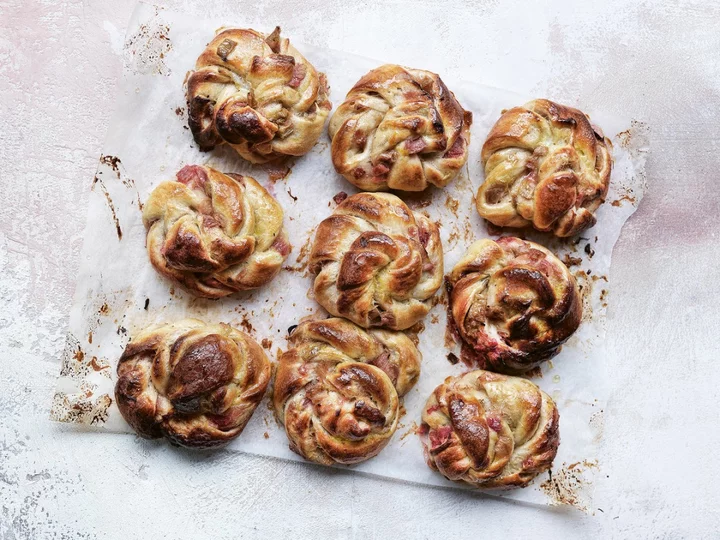
Rhubarb sticky buns for an idyllic Scandinavian afternoon tea
In Scandinavia, we are famous for our cinnamon and cardamom buns, made with a soft, yeasty dough,” says Trine Hahnemann, author of Simply Scandinavian. “I decided to try them with rhubarb in place of the spices, since it is a local vegetable for me. Just like the original, these buns are soft, sweet and sticky.” Rhubarb sticky buns Makes: 14-16 Ingredients: For the buns: 300g rhubarb 100g caster sugar 50g fresh yeast, or 10g fast-action dried yeast 200ml lukewarm whole milk 100g full-fat crème fraîche 1 egg, lightly beaten 650g strong white flour, plus more to dust 1 tsp sea salt flakes 100g salted butter, softened For the filling: 100g salted butter, softened 50g caster sugar 100g marzipan, grated Method: 1. Cut the rhubarb into one-centimetre pieces, place in a saucepan with 50 grams of the sugar and bring to the boil. Cook for five minutes, then drain through a sieve placed over a heatproof bowl. Return the juice to the pan, bring to the boil once more and cook down until you have a syrup. Leave to cool. 2. Dissolve the yeast in the lukewarm milk in a bowl, then stir in the crème fraîche and egg. Next, mix in the flour, the remaining 50 grams of sugar and the salt. Knead the butter, little by little, into the dough, then knead well on a floured work surface until smooth. 3. Put the dough in a bowl, cover with a tea towel and let it rise for one to two hours, or until doubled in size. 4. Make the filling by mixing the butter, sugar and marzipan into a smooth paste. 5. Line some baking sheets with baking parchment. 6. Tip the dough out on to a floured work surface and roll it into a rectangle measuring about 40 x 30 centimetres. Spread the filling evenly over half the dough, then arrange the cooked rhubarb pieces on top of the filling. Fold the plain side over the filled side, then cut across into two-centimetre strips. 7. Take each strip and twist it, then roll each twist into a spiral. 8. Place the rhubarb buns on the prepared trays, pressing down on each so they spread slightly. Cover and leave to rise for 30 minutes. 9. Preheat the oven to 180C/350F/gas mark 4. 10. Bake the pastries for 25-30 minutes, then remove from the oven and brush with the rhubarb syrup. Leave to cool on a wire rack before serving. ‘Simply Scandinavian’ by Trine Hahnemann (Quadrille, £27). Read More Budget Bites: Three light recipes that sing of summer What the hell is Scandinavian food? Lighter fish pie: Comfort food you won’t feel guilty for eating How to make Norwegian potato pancakes Three quick and easy plant-based fakeaways to create at home The Union Rye, review: Finally, a decent restaurant in this charming East Sussex town
2023-06-29 21:20
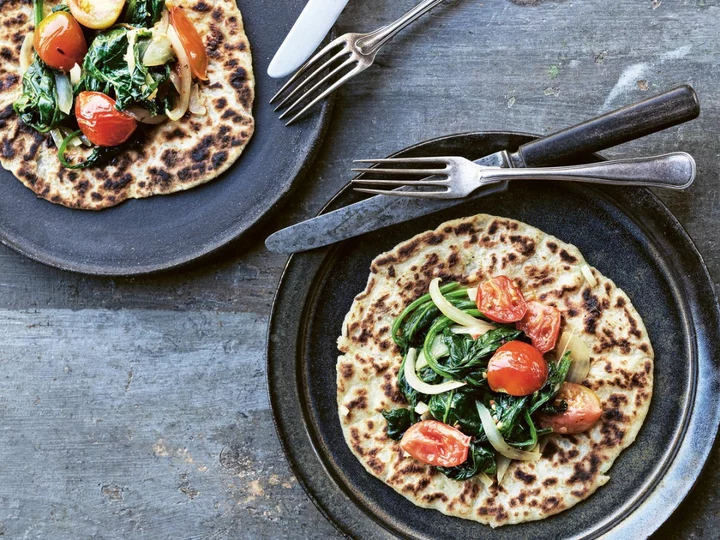
How to make Norwegian potato pancakes
A Norwegian tradition at weddings. In the old days, in small towns in Norway, all the women would gather together to make really big potato pancakes to be eaten at wedding breakfasts!” says Trine Hahnemann, author of Simply Scandinavian. “This recipe takes a little planning because you need to prepare the potatoes the day before to allow their starch to settle, in order to be able to roll out the dough.” Potato pancakes Makes: 10 Ingredients: For the pancakes: 500g peeled potatoes 50g salted butter 50g full-fat crème fraîche 1 tsp sea salt flakes 175g plain flour, plus more to dust Freshly ground black pepper For the topping: 200g spinach 4 tomatoes 1 onion, sliced 1-2 tbsp salted butter 2-3 tbsp full-fat crème fraîche Method: 1. The day before you want to make the pancakes, boil the potatoes until tender. Drain them, then pass through a potato ricer into a bowl and add the butter, crème fraîche and salt, with some pepper. Mix well, then cover and refrigerate overnight. 2. Next day, mix the flour into the potato mixture and divide the dough into 10. Roll each piece out on a floured work surface into a circle 12 centimetres in diameter. Cook each one in a dry frying pan, turning it once. You will know they are ready when they are light brown on both sides, which will take two to three minutes on each side. 3. For the topping, rinse the spinach in cold water and drain well; it may take several rinses to get it properly clean. Cut the tomatoes in half and discard the juice and seeds, then slice them. Sauté the onion in the butter until golden brown, then add the spinach and wilt it, seasoning to taste with salt and pepper. Turn the heat off, add the tomatoes and mix. 4. Serve the warm pancakes topped with the vegetables, with crème fraîche on the side. ‘Simply Scandinavian’ by Trine Hahnemann (Quadrille, £27). Read More Budget Bites: Three light recipes that sing of summer What the hell is Scandinavian food? Lighter fish pie: Comfort food you won’t feel guilty for eating Three quick and easy plant-based fakeaways to create at home The Union Rye, review: Finally, a decent restaurant in this charming East Sussex town Missing Glastonbury? Here’s how to have a festival feast at home
2023-06-29 19:17
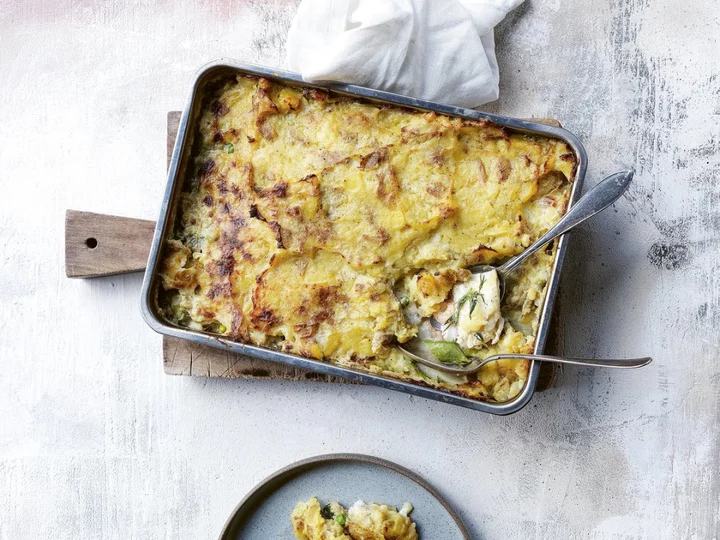
Lighter fish pie: Comfort food you won’t feel guilty for eating
The ultimate comfort food, but also light; this recipe manages to be creamy and filling without you having to take a nap afterwards, which can be the case with heavier meat dishes,” says Trine Hahnemann, author of Simply Scandinavian. “It can be made with any fish, or also with the same weight of vegetables instead. This kind of pie will always do it for me when I’m in need of energy and comfort.” Fish pie Serves: 6 Ingredients: 800g large potatoes, chopped into big chunks 100g salted butter, plus 3 tbsp, plus more for the dish 500g firm white fish fillet, chopped into small pieces 300g raw prawns, sustainably caught 10 white asparagus spears 10 green asparagus spears 2 shallots, finely chopped 200g shelled fresh peas 5 dill sprigs, chopped Sea salt flakes and freshly ground black pepper Leaves from 2-3 sprigs of flat-leaf parsley, chopped, to serve (optional) Method: 1. Boil the potatoes in water until tender. 2. Butter a large ovenproof dish generously, then add the chopped fish and prawns in an even layer. Season with salt. 3. Snap the lower one-third of the white and green asparagus off, then peel the white asparagus until shiny and cut all the asparagus spears into four-centimetre pieces. (The trimmings and peelings can be used in soup). Fry the shallots gently in a frying pan in one tablespoon of butter. Turn off the heat, add the asparagus, peas and dill, mix well and season with salt and pepper. Arrange the vegetable mixture on top of the fish. 4. Preheat the oven to 200C/400F/gas mark 6. When the potatoes are cooked, drain them, reserving 100 millilitres of their cooking water. Mash the potatoes lightly together with the reserved cooking water and the 100 grams of butter, keeping the mash chunky. Season to taste with salt and pepper, then spread the mash over the pie filling and place the remaining two tablespoons of butter, in small dots, on top. 5. Bake for 30 minutes. Let it rest for a few minutes, then scatter with parsley and serve. ‘Simply Scandinavian’ by Trine Hahnemann (Quadrille, £27). Read More Budget Bites: Three light recipes that sing of summer What the hell is Scandinavian food? Three quick and easy plant-based fakeaways to create at home The Union Rye, review: Finally, a decent restaurant in this charming East Sussex town Missing Glastonbury? Here’s how to have a festival feast at home Four berry sweet recipes that go beyond strawberries and cream
2023-06-29 17:25
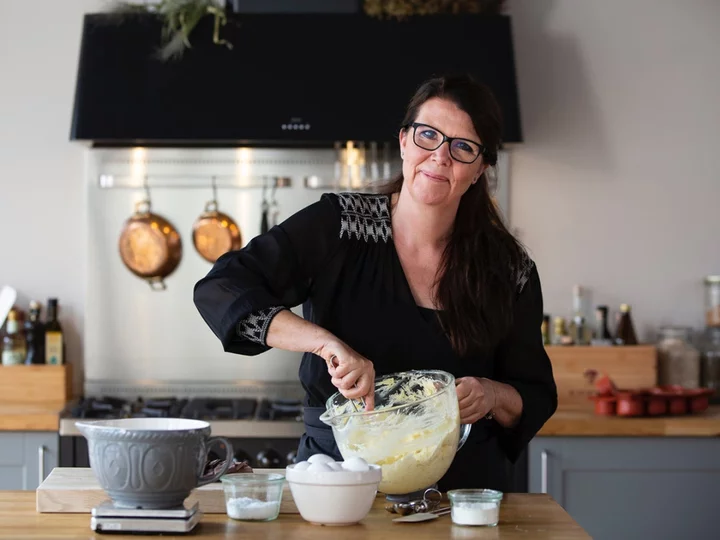
What the hell is Scandinavian food?
Danish pastries are world-famous, but what do you know about the rest of Scandinavian cuisine? With a food philosophy that centres around seasonal produce, perhaps the Scandi approach to cooking is the way forward when considering the environment and the cost-of-living crisis. “It’s very seasonal, lots of vegetables and very clean flavours,” Copenhagen-based chef and food writer Trine Hahnemann says of Danish cuisine. “So salt, pepper, nutmeg; salt, pepper, lemon; salt, pepper, vinegar – it’s not bland at all, we use spices, but we use them one at a time.” Hahnemann, 58, says this emphasis on seasonality helps save money. “It becomes too expensive to buy vegetables that are out of season, that are shipped or whatever,” she explains – but she’s all to aware that the Danish food scene is a bit of a paradox. She mentions produce “that have become everyday things, which people eat every day – like cucumbers, tomatoes and bananas. You can’t convince people there’s also a season for bananas – it’s year round, all the time. They’re the biggest fruit in Denmark”. This doesn’t stop Hahnemann advocating for eating the seasons – which in Denmark means you might be limited to root vegetables and potatoes in the winter. This isn’t necessarily a bad thing, particularly as we’re now coming into summer and there’s a glut of fruit and vegetables available. Summer cabbage, radish, fennel, tomatoes, cucumbers, courgettes, strawberries, tomatoes – they’re all in her shopping basket during this time of year. Hahnemann is a salad fan, and she’s devoted a whole section of her new cookbook, Simply Scandinavian, to them. The chef argues people “don’t take [salads] seriously enough” – and opening a bag from the supermarket won’t quite cut it. “Buy a few vegetables, bake them nicely in the oven with either lemon juice and a little bit of a spice of some kind – it could be garam masala, it could be garlic – then always have a nice dressing. Spend some money on some good oils or good vinegars, because that’s where the flavours are. “Then think about texture… Texture means a lot when we eat.” The moral of the story? “Salads are amazing, because there are no rules – anything can become a salad,” she says. Hahnemann learned traditional Scandinavian cooking from her grandmother, saying: “My favourite dish when I was little that my grandmother would cook for me was meatballs with the cucumber salad.” Her grandma ever explicitly taught her how to make this dish – Hahnemann was instructed to help out, and eventually learned classic Danish recipes through osmosis. “It was much later in my 20s I realised what an amazing gift she’d given me without ever asking if I wanted to be involved – because I was involved, but I was never asked to be part of the cooking. I just saw it all tasted it,” Hahnemann says. Not that feeding Hahnemann was much of a chore: “When I was a child I loved everything. The only thing I didn’t like was a well-done omelette, that was the only thing I couldn’t eat when I was little.” Hahnemann’s grandmother also taught her how to bake, drawing upon the traditional recipes Denmark is famous for. As a child, she practised baking while living on a commune with her parents in the Sixties and Seventies. “There was this idea that children, their creativity should be nurtured, you shouldn’t put limits on things. So I baked all these horrible cakes and the grown-ups would eat them and say, ‘Oh, it’s wonderful Trine’ – and it was nothing like that,” Hahnemann remembers with a laugh. It was only when someone in the commune started giving her tips on beating the butter and sugar before adding the rest of the ingredients that “all of a sudden this world opened up to me about baking”. Hahnemann still uses baking as a tool when she’s “really stressed out”, and has a bakery in Copenhagen putting the spotlight on traditional Scandinavian bakes like cardamom buns and rye bread. She says baking is “the most important thing” about Scandinavian cuisine. “Because of the rye bread, and the whole lunch concept of open sandwiches on the rye bread. The whole breakfast is about bread, then you have all the celebratory baked goods – that you can say we now eat on a more regular basis.” While Hahnemann accepts some “traditions are disappearing, because everybody’s working so much”, she’s keen to keep the spotlight on traditional buns, breads and baking. When she recently taught a baking class, she was “so happy” to have a group of male friends in their 20s sign up, saying: “I think it’s important to keep it alive.” ‘Simply Scandinavian’ by Trine Hahnemann (Quadrille, £27).
2023-06-29 13:53

What’s the Difference Between Ice Cream and Gelato?
You know it's summer when going to the local ice cream or gelato shop becomes part of your daily routine. But what exactly is the difference between these two frozen treats?
2023-06-29 05:19

‘This could get me in trouble’: Michelin chef comes up with controversial alternative to barbecuing burgers
Michelin-starred chef David Chang has poured cold water on the idea that grilling burgers on a barbecue is the optimum way to cook them. The founder of Momofuku Ko, which has two Michelin stars, said that barbecuing patties only serves to turn them into “carbonised crap”, but people keep cooking them like this because of the socialising that is associated with cooking outdoors. On his podcast The Dave Chang Show, the controversial chef suggested that using a griddle to cook burgers is a superior method. Chang, 45, said: “Grills suck for burgers. We have assumed as a culture that in summer, we eat a burger and it’s grilled. “I actually think the grill is a horrible thing for the burger… I think this viewpoint could get me in trouble,” he admitted, but pressed on with his argument against the grill. “The success rate of the griddle is better than the grill, and also there’s no clean up, you have nothing to worry about.” The Korean-American restaurateur continued: “A juicy burger is going to turn into a guaranteed grease fire [on a barbecue], why use it? This whole idea of imparting flavour from the grill, the only flavour that’s being imparted is the carbonised crap that’s on it. “You would need to cook a burger over charcoal for 12 hours to get that smoky flavour. “A backyard burger is an experience that you try to convince yourself is better than it actually is,” he claimed. “It’s the nostalgia, it’s the smells, it’s your friends. But if you actually take it out of the context, it’s not that good.” Chang went on to allege that the close relationship between burgers and grills “is a marketing lie”. “How many places where you think have a good burger, cook it on a grill?” he challenged. However, he did have some praise for barbecued foods. Chang said that grilling corn was “clearly the only champion” and he “can’t think of anything else” that makes corn taste quite as good. Chang has previously shared his opinions on burgers that landed him in trouble. In 2015, he provoked the ire of Australians when he wrote in his blog Lucky Peach: “You know who f***s up burgers more than anyone else in the world. Australians. Australia has no idea what a burger is. “They put a fried egg on their burger. They put canned beetroot on it, like a wedge of it. I am not joking you. This is how they eat their burger.” He also laid waste to the use of wagyu – beef that comes from cattle that is bred in Japan and is highly prized for its marbled fat content – in burgers. In his “burger manifesto”, Chang wrote that it was “the dumbest burger in the world” to use wagyu. “It’s like 70 per cent fat content – it’s disgusting. Would you eat a ground bacon burger? That’s what you’re doing with a wagyu burger,” he said. “Or the idiots that have ‘kobe beef wagyu sliders with a trio of ketchup’ on their menu – that drives me insane.” The chef is also known for speaking candidly about his toxic behaviour while working in kitchens in the past. In his 2020 memoir Eat a Peach, Chang wrote: “When I’m angry, I seethe with such intensity that it can’t simply be emotional. It’s like I’m an animal registering danger.” Hannah Selinger, an award-nominated journalist, wrote in her essay for Eater that “in all my years of restaurant work, I had never seen anything like the roiling, red-faced, screaming, pulsing, wrath-filled man that was David Chang”. She worked as corporate beverage manager at the Momofuku restaurant group in 2008. Chang responded to Selinger’s essay and said that while he didn’t recall specific incidents mentioned by her, “they are entirely consistent with my behaviour at the time, which I did not begin to correct until several years later”. He added that “the bottom line is that I’m sorry”. Apart from his podcast, Chang also hosted Netflix’s travel and food series Ugly Delicious from 2018 to 2020. The show aired two series and featured celebrity guests including Jimmy Kimmel and Nick Kroll. Read More Walk this way... but not like that: How men’s walks became sexualised Jonnie Irwin makes rare red carpet appearance as he says ‘every day is a gift’ Influencers face backlash for promoting Shein factory during PR trip in China Budget Bites: Three light recipes that sing of summer Danny Dyer explains why he has a Toby Carvery Platinum Gold Card Three quick and easy plant-based fakeaways to create at home
2023-06-28 16:51
You Might Like...

You Can Donate Your Leftover Halloween Candy to American Troops and First Responders
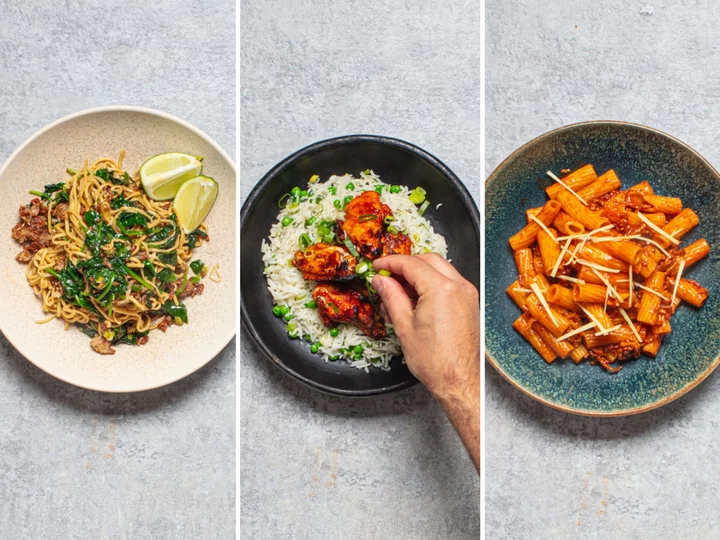
Three wallet-friendly recipes to keep food bills down before pay day

Exclusive-Tyson Foods plans to sell China poultry business -sources

Subway offers free sandwiches for life contest if you legally change your name

Shoppers on food stamps buy less and go to food banks as benefits shrink

20 Fall Harvest Words and Their Origins

‘Fried rice syndrome’: Dietitians warn against eating food left out at room temperature

The 25 Best Bars in the U.S.
